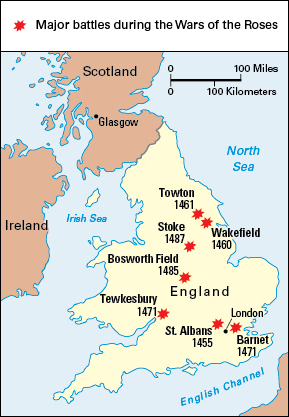Towton, Battle of, was fought in 1461 during the Wars of the Roses (1455-1485), a series of civil wars in England. The armies of York and Lancaster fought the battle between the villages of Towton and Saxton in Yorkshire, in northeastern England. The battle ended in a decisive Yorkist victory.

Edward, Earl of March, had himself proclaimed King Edward IV of England soon after the death of his father, Richard of York, in 1460. However, England at that time already had a king—Henry VI, of the House of Lancaster. The two sides went to war to decide who would rule England.
After three indecisive battles, the Yorkist and Lancastrian armies met again on March 29, 1461. The battle began on a snowy meadow with the armies positioned on either side of a shallow depression called Towton Dale. Edward commanded the Yorkist army, which may have included as many as 35,000 soldiers. The Duke of Somerset commanded the slightly larger Lancastrian force, possibly with as many as 40,000 troops. Henry and his wife, Queen Margaret, remained at their headquarters in York.
The two sides remained evenly matched until a Yorkist force under the Duke of Norfolk arrived to reinforce Edward. The fresh troops smashed the Lancastrian line, which broke and fled. The pursuing Yorkists killed the enemy soldiers they encountered because no quarter was given—that is, no prisoners were taken. The victory secured the throne for Edward IV.
Several accounts following the battle estimated that 28,000 soldiers had died. Many modern historians believe those estimates were high. Nevertheless, the Battle of Towton is generally considered the biggest and bloodiest battle ever fought in what is now the United Kingdom. The battle also marked the earliest known use of firearms on a British battlefield. Today, a restored medieval cross marks the battlefield at Towton Dale. Mass graves on the site contain thousands of soldiers killed in the battle.
